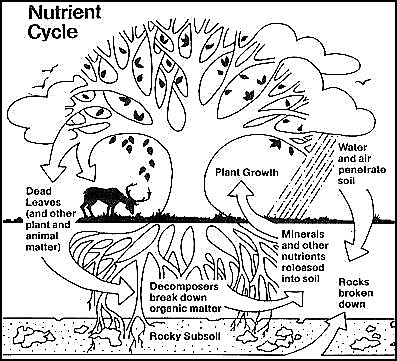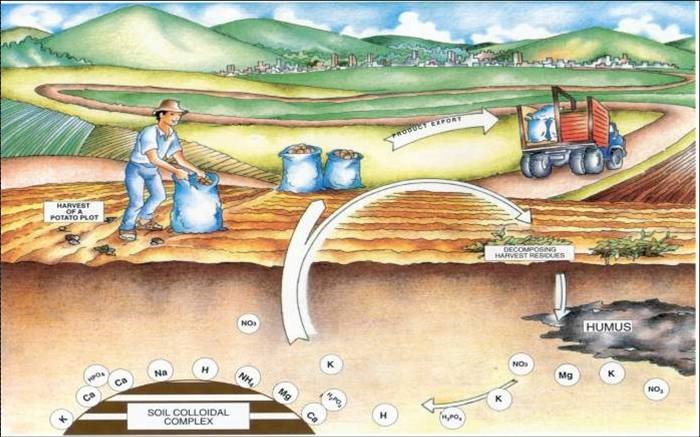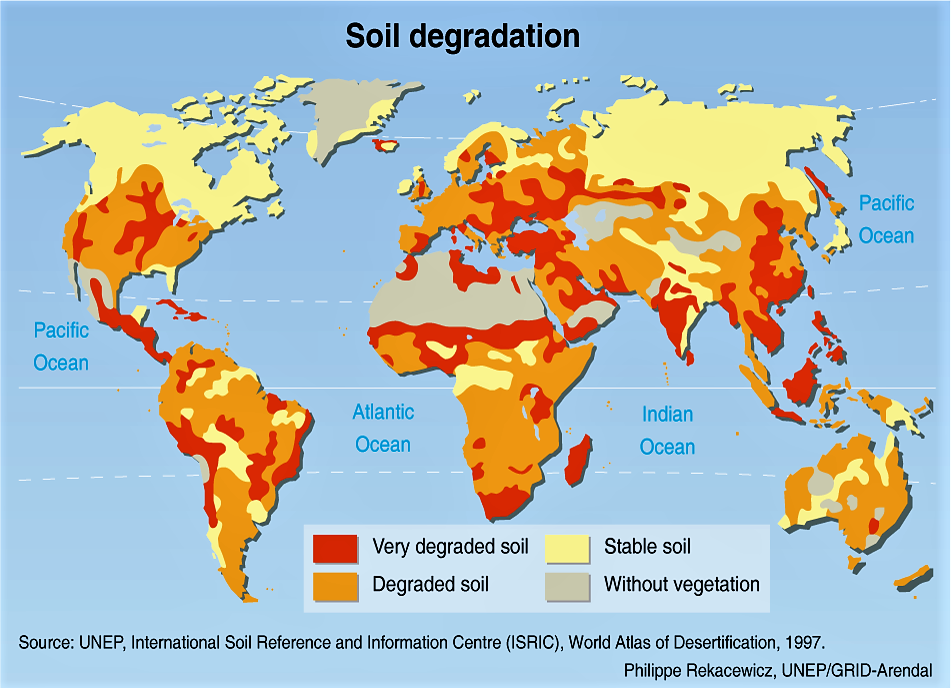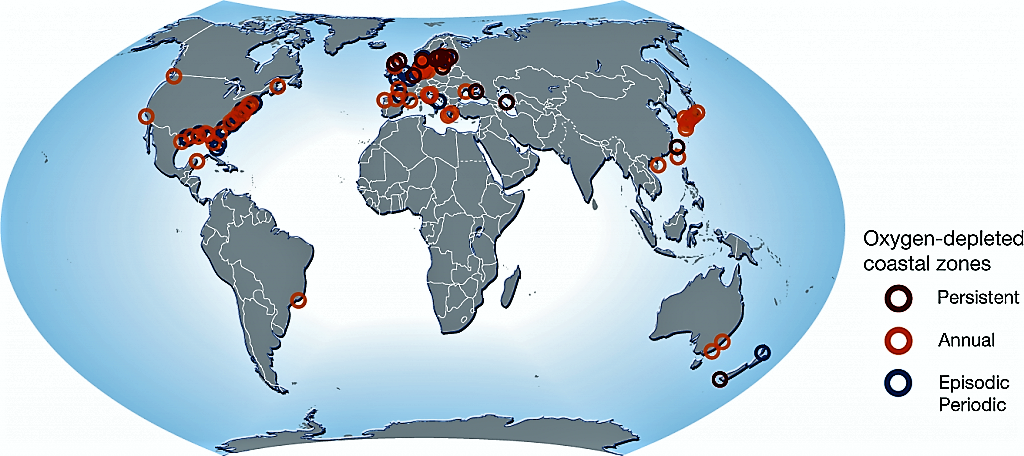Where Is This Statement Found : Organic Power to Flourish Again.
29 June 2019
The Nutrient Cycle
Executive Summary
The food cycle describes how nutrients move from the physical environment into living organisms, and subsequently are recycled dorsum to the physical surround. This movement of nutrients, essential for life, from the environment into plants and animals and back again, is a vital office of the ecology of any region. In whatsoever particular environment, the nutrient cycle must be balanced and stable if the organisms that live in that surroundings are to flourish and exist maintained in a constant population (MARTIN 2010). Currently, big parts of humankind influence the nutrient bicycle in such a way that we remove nutrients from the land and discharge them into aquatic environments. On the one mitt, this leads to soil depletion on the state, and on the other manus, an glut of nutrients and pollution of h2o sources.
Nutrients — the fuel of life
Factsheet Cake Body
Nutrients are chemical elements that all plants and animals crave for growth. On the earth, there is a abiding and natural bicycle how these elements are incorporated when an organism grows, and degraded if an organism dies. The nutrients used in the largest amounts are the non-mineral elements, i.eastward. carbon (C), hydrogen (H) and oxygen (O). These elements are mainly taken upwardly as carbon dioxide (CO2) from the air, and water (H2O) by the roots (JOENSSON et al. 2004). They brand up 95-98% of the mass of all living beings (MAHENDRAPPA 2007). Simply they are, nonetheless, not sufficient for life to exist.
Farther elements are important to fuel life on earth: Nitrogen (Northward) and Phosphorus (P), Potassium (K) as well as Calcium (Ca) and Magnesium (Mg) are highly important, in particular for establish growth and agriculture. These elements are oft referred to equally macro nutrients. Their uptake is about 100 times that of micro nutrients. Further nutrients, that plants accept up in a much smaller amount and that are essentially consumed by humans, include Boron (Bh), Copper (Cu), Fe (Atomic number 26), Chloride (Cl), Manganese (Mn), Molybdenum (Mo) and Zinc (Zn) and others. These are called micro nutrients (JOENSSON et al. 2004).
Natural nutrient cycles
Factsheet Block Trunk

These nutrients – essentially chemical elements – are continuously in a round movement, the nutrient cycle. The food cycle is hence a full general term that describes how nutrients movement from the physical environment into living organisms, and are subsequently recycled back to the physical environment (MARTIN 2010). Nutrients in the soil are taken up by plants, which are consumed by humans or animals, and excreted again by them — or they are released dorsum into the environment when organisms dice (e.g. plants lose their leaves). Microorganisms in the soil break this matter down, and again brand nutrients available in their mineral grade, which makes it possible for plants to have them upwardly once again (see also nutrient requirements of plants).
Substantially, all nutrients that plants and also human beings require to survive are cycled in this manner. In relation to water management and sanitation, it is mainly N, P and One thousand that are of loftier priority. They are the most important nutrients to sustain plant growth and agriculture, and thus humanity.
How humans influence food cycles
Factsheet Block Body

As described above, nutrients are continuously recycled in a natural ecosystem. In recent decades, population growth and resulting homo activities such equally large-calibration farming have caused some significant changes in food cycles.
With harvesting crops, nutrients are removed from the soil. For centuries, dung from animals has been used equally a fertiliser to restore the nutrients back to the soil, and in many cultures – e.chiliad. in Europe, or also in Mainland china, also human excreta have been recycled back to agronomical fields. Hence, nutrients went back into the soil at roughly the rate they had been withdrawn. All the same, with the introduction of water-borne sewage, this wheel was interrupted and replaced past a linear system that transports nutrients away from soils and into watercourses (run into also h2o pollution).
Furthermore, agriculture also influences the nutrient cycle in another way: agriculture accelerates state erosion — because ploughing and tilling disturb and expose the soil — so more nutrients drains abroad with runoff (encounter likewise soil degradation). And flood control contributes to disrupting the natural nutrient bicycle. Typically river floods would redistribute nutrient-rich sediments to lower lands where it is again available for ecosystems. Instead dams trap sediment or embankments confine it to the river until it washes out to sea. So too much nutrients from eroded soil and from man and animal waste ends up in lakes and oceans, where information technology spurs massive, uncontrolled blooms of algae. One time they dice and fall to the lesser, their disuse starves other organisms of oxygen, creating "dead zones" and contributing to the depletion of fisheries (VACCARI 2009).

Essentially, the human alterations to the nutrient cycle leads to an excess of nutrients in aquatic ecosystems and a serious lack of nutrients in agronomics. Worldwide, more and more soils are deplete of nutrients, with serious consequences to agricultural production and food security.
The lack of nutrients in agriculture is oftentimes made upwardly by applying bogus fertilisers. Still there are several bug related to this strategy:
- Artificial fertilisers usually contain only the most important macro nutrients nitrogen, phosphorus and potassium and lack other essential trace elements. This eventually leads to a soil deplete in micro nutrients.
- Phosphorus is a finite resource. "China, Morocco and the United States alone currently produce most two thirds of global phosphate. Estimates on the remaining amount of phosphorus vary, as do projections about how long it will take to deplete the irreplaceable resource entirely. Figures for easily exploitable reserves range from lx-130 years (TIESSEN 1995; STEEN 1998), but all sources concur that connected phosphorus production will reject in quality and increment in cost. It imperative that nosotros begin recycling phosphorus and returning it to the soil to decrease the need for mined phosphorus as bogus fertiliser. Within a half century, the severity of this crunch volition result in increasing food prices, food shortages and geopolitical rifts."
- Nitrogen, on the other hand, is available abundantly. 78% of the air is composed of nitrogen. However, the procedure of producing nitrogen is highly energy consuming and relies mostly on fossil fuels – which, on the other hand, are finite.
- The element potassium is bachelor abundantly, and reserves are predicted to concluding for a long fourth dimension. However, most of the potassium is contained in pocket-sized proportions in a large number of mineral formations which makes extraction laborious.
Essentially, the trouble with the human alterations to natural nutrient cycle is the 1 that we are extracting nutrients from the soil, and discharging them substantially in aquatic environment – this leads to a heavy imbalance with severe consequences.
Consequences
Factsheet Block Torso

These human-induced alterations in the food cycles lead to an imbalance in the availability of nutrients, whose consequences, in detail with regard to water, are grave:
- Depletion of soils: The accumulation of nutrients in the seas ways that they are depleted elsewhere, i.e., to a big extent from soils. This leads to the fact that many of the fruit and vegetables that animals and humans are consuming, essentially comprise less nutrients, minerals, vitamins etc. that they have some decades ago. Applying more than artificial fertilisers is not the solution: information technology is energy and cost intensive; information technology can lead to salinisation, and, because artificial fertilisers which are mainly based on the iii main components Nitrogen, Phosphorus and Potassium, are essentially incomplete. Furthermore, soils that practice not comprise adequate amounts of organic material (e.one thousand. from compost, dead plant material etc.), are non able to adsorb much of the nutrients added, and too take a depression water property capacity.
- Depletion of nutrient sources: While nitrogen can be gained from the air, it is an energy intensive process that is mainly based on the use of fossil fuels. Other components of artificial fertiliser, are based on fossil resources, such as phosphorus. The corporeality that is easily mined, is limited (see to a higher place). If these easily mineable resources are deplete, this means that phosphorus prices will increase drastically.
- Affordability & food security: "Fertilisers are leap to world market prices which are already substantially high for many farmers from developing countries. An increment in price, as is to exist expected in the case of phosphorus, will make them unavailable for many farmers. This may make agricultural products, particularly in developing countries, more expensive and thus pb to a decreased food security." (CONRADIN 2007).
- Eutrophication of waterways and dead zones: "Fertiliser runoff and wastewater discharge contribute to eutrophication, uncontrolled blooms of algae in rivers, lakes and oceans, feeding on nitrogen and phosphorus from fertilisers. When they die, their decomposition depletes the water of oxygen and slowly chokes aquatic life, producing "dead zones." The largest dead zone in American waters, topping 20,000 square kilometres in July 2008, is off the Mississippi delta. More than 400 dead zones now be worldwide, roofing a combined area of more than 245,000 square kilometres." (CASTELVECCHI 2009) (see also water pollution).
Outlook
Factsheet Block Body
At the moment, humans influence natural food cycles in an unsustainable way, and in a one-mode direction. Too many nutrients end up in the sea, and are lacking on the land, leading to the in a higher place mentioned consequences. A new approach in nutrient direction is needed, essentially incorporating a new fashion to look at what nosotros usually phone call wastewater too: this is, not to consider wastewater as a waste, but as a resource, full of nutrients that can be recycled and reused (come across reuse and recharge section).
Sensation Raising Fabric
Where Is This Statement Found : Organic Power to Flourish Again.
Source: https://sswm.info/arctic-wash/module-2-environment-pollution-levels-implications/further-resources-environment-and/the-nutrient-cycle

0 Response to "Where Is This Statement Found : Organic Power to Flourish Again."
Post a Comment